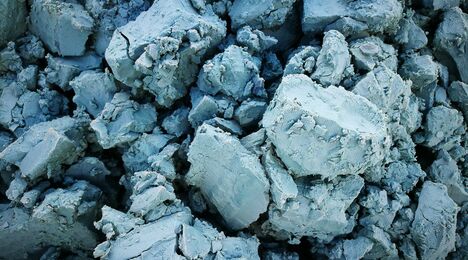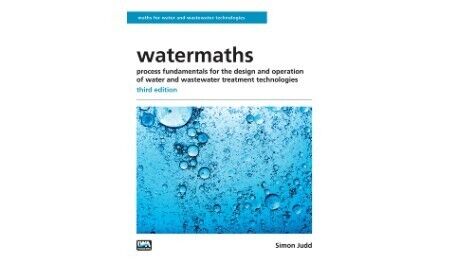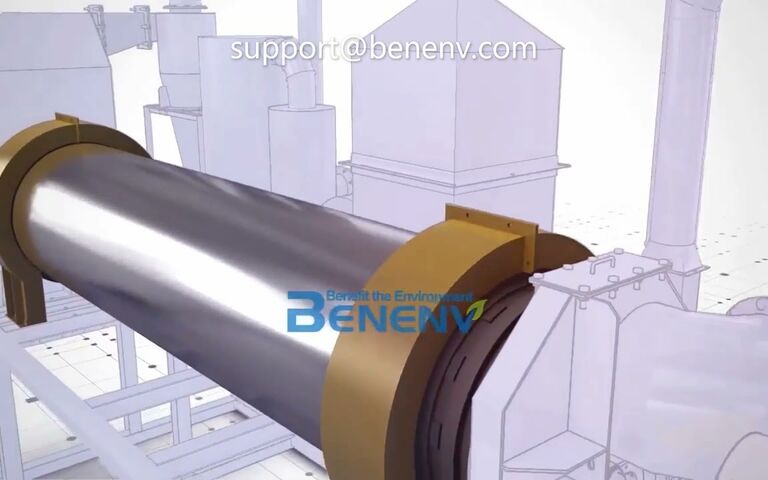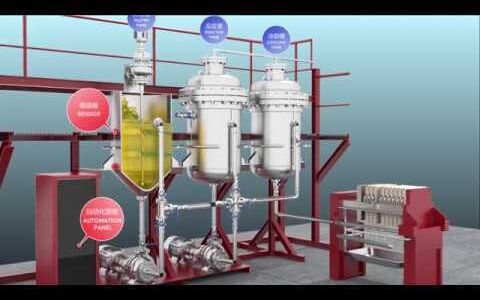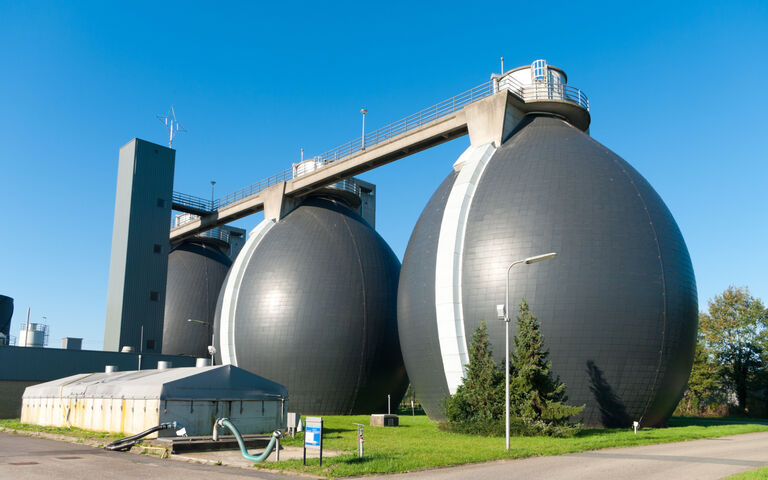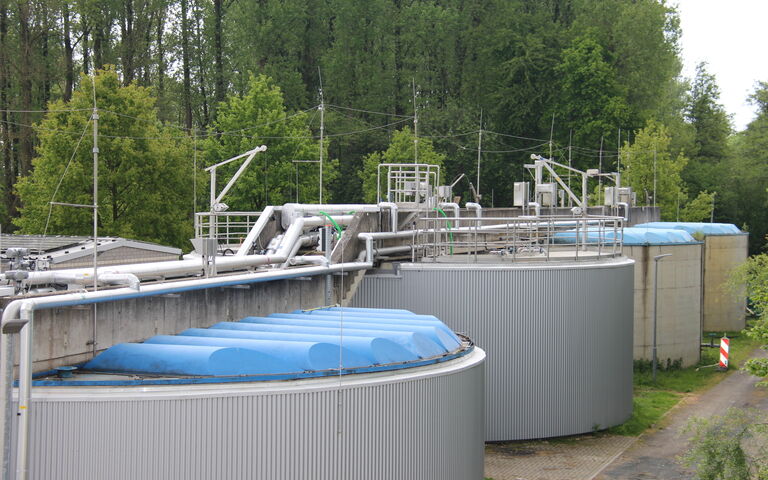Anaerobic digestion optimization through thermal hydrolysis pre-treatment


Nasreen Nasar and Yadira Bajón Fernández, Cranfield Water Science Institute, Cranfield University, UK
Dr Yadira Bajón Fernández (pictured left) is a Senior Lecturer in Bioresources Science and Engineering at CWSI, with a specialist interest in anaerobic digestion and in innovative flowsheets for sewage sludge and organic waste treatment
Nasreen Nasar (pictured right) is a PhD researcher at CWSI with a keen interest in waste management and resource efficiency in water recycling centres
1. Introduction
The pre-treatment of sludge by thermal hydrolysis (TH) upstream of anaerobic digestion (AD) is used as a means of improving AD efficiency. It offers a means of overcoming the various constraints imposed by the high sludge bulk viscosity, limited suspended solids (SS) solubility and innately slow hydrolysis reactions of the macromolecular organic compounds (chiefly proteins, polysaccharides and lipids). TH subsequently improves:
- mixing efficiency and solids loading (by 2−3 times compared with conventional mesophilic anaerobic digestion, or MAD), as a result of the reduced viscosity
- substrate bioavailability, leading to more efficient bioconversion to methane (i.e. a higher biogas yield)
- biokinetics, through uncoupling of the rate-limiting hydrolysis step and the anaerobic digestion stages resulting in shorter hydraulic retention times (HRTs), and
- biosolids reduction, through the enhanced degradation of the organic solids.
Although originally applied in the early 70s for enhancing sludge dewaterability, greater emphasis is now placed on enhancing biogas production and solids throughput. However, these two parameters are not necessarily mutually applicable for optimisation purposes.
A study has been conducted based on eight months of commissioning and pre-commissioning data for a full-scale UK-based AD installation undergoing upgrading with TH. The practical work was supported by a review of literature data along with previous studies at Cranfield University. The study aimed to assess the basis for optimisation, using available data for:
- feed sludge physicochemical properties, and
- digester stability and performance with reference to volatile solids (VS) reduction and ammonia levels.
2. Methodology
The plant comprised four blocks of four digesters, each with a working volume of 4160 m3. Three Cambi TH units were retrofitted into three of the four blocks. Site-based commissioning data supported by data from previous analysis of samples obtained from the site (Table 1) were used in the analysis, supplemented by published literature data to support areas such as microbial dynamics and methanogen pathways fate.
| Sample | Pre commissioning1 | During commissioning1 | During/post commissioning2 |
|---|---|---|---|
1Data recorded from site commissioning; 2Data relating to past analysis of samples from full-scale site. DS dry solids, VS volatile solids, VFA volatile fatty acids, TAN total ammonia nitrogen, FAN free ammonia nitrogen, T temperature; P phosphorus, SS suspended solids, TA total alkalinity; COD chemical oxygen demand | |||
| Primary sludge | %DS, %VS, pH, volume transferred | %DS, %VS, pH, volume transferred | - |
| Secondary sludge | %DS, %VS, pH, volume transferred | %DS, %VS, pH, volume transferred | - |
| Pre-THP dewatered sludge | - | %DS, %VS | - |
| Digester feed | %DS, %VS | %DS, %VS | %DS, %VS, TA, pH, VFA, TAN, FAN, Total and soluble COD |
| Digestate | %DS, %VS, pH, VFA, TA, TAN, FAN, VFA/TA and T | DS%, VS%, pH, VFA, TA, TAN, FAN, VFA/TA, TA, T | TA, pH, VFA, TAN, FAN, COD |
Site data referred to an eight-month period encompassing operation prior to and during commissioning:
- Pre TH-AD commissioning: 14/11/2017 − 03/03/2018
- TH-AD commissioning: 18/03/2018 − 04/07/2018
Data analysis was based on 2-day moving average values. Data synthesis and subsequent interpretation then proceeded through the following:
Collation of site sludge chemical quality data comprising total and soluble COD (TCOD, SCOD), total and free ammonia (TAN, FAN) and pH, along with the total feed sludge N content. The latter was determined through the dissolved solids (DS) data, based on reported literature correlations.
Accordingly, the %TN was found to make up 1.5−4% of the DS in raw primary sludge and 1.4−8% in the waste activated sludge (WAS). Within this range, %TN values of 4% and 6.5% of the VS for the primary sludge (PS) and secondary (waste activated) sludge (WAS) respectively were determined as being most pertinent to the installation under study. These proportions yielded ammonia levels in close agreement with those for the MAD feed.
Determination of performance and stability parameters of MAD and TH-AD comprising VFA/TA or Ripley ratio, VFA concentrations, digester pH, % methane in biogas and volatile solids reduction (VSR) – the latter calculated by mass balance. Since TH heavily influences high solids loading and digester ammonia nitrogen concentrations, these indicators were studied with reference to TAN, FAN, TA, and organic and nitrogen loading rates (OLR and NLR respectively). Of these, FAN, VSR and NLR were derived from the raw data, the NLR being a percentage of the OLR assuming negligible loss of nitrogen from dewatering.
The specific energy loading rate (SELR in gCOD/gVS/d) was also calculated to establish whether the VFA loading rate was within the limits for maintaining methanogenesis, the threshold maximum value considered as being 0.3 [1].
Ammonia release was normalised against the VS destroyed for both MAD and TH-AD, based on the change in TAN and VS across the process. % conversion of organic nitrogen (ON) to TAN was determined from the feed ON and TAN released.
3. Results
3.1 Impacts on feed sludge characteristics
Sludge characterisation (Table 2) indicated a four-fold increase in FAN from applying TH. Negligible TN loss from dewatering was assumed, the TN assumed to be 81−99% insoluble.
| Parameter | Pre-TH dewatered sludge | TH-AD feed | MAD feed |
|---|---|---|---|
*from lab study; 1calculated; 2from literature values for %N in primary and waste activated sludge | |||
| %TS | 16.3 ± 0.07 | 9.2 ± 0.07 | 4.2 ± 0.2 |
| %VS | 77 ± 2 | 77.8 ± 0.2 | 78 ± 2.6 |
| Total COD* (mg COD/g sludge) | 192 ± 14 | 103 ± 4.9 | No data |
| Soluble COD* (mg/L) | 21,827 ± 326 | 21,567 ± 245 | No data |
| pH | No data | 5.7* | 5.5* |
| TAN (mg/L) | No data | 327 ± 120 | 126 ± 15 |
| FAN (mg/L)1 | No data | 0.22 ± 0.01 | 0.05 ± 0.01 |
| TN (%VS)2 | 4.8 | 4.8 | 4.8 |
TH pre-treatment is known to enhance protein solubilisation and promote protein, polysaccharide and lipid degradation. It also increases the humic acid concentration, which may then possibly stabilise trace metals through chelation.
The WAS fraction had significantly higher concentrations of soluble COD, containing low molecular weight (LMW) proteins and carbohydrates, than PS. This increased the potential for generation of recalcitrant compounds such as melanoidins through TH at temperatures above 160°C. A temperature of 140−160°C was thus proposed as the optimum range for sustaining performance while limiting the impact of refractory COD (rCOD) content on biogas yield. Against this, a temperature of 160−200°C is considered optimum for enhancing digestate dewaterability. Literature suggests that limiting the temperature to 160°C reduces the attainable DS cake content to 30±3% compared to the optimum range of 33±2% achieved at the higher temperature range [2]. The plant operated at a temperature slightly higher than this range (165oC), but with a low WAS fraction.
TH allowed a doubling of the %TS, from 4.6% before TH commissioning (not shown in table) to 9.2% afterwards, primarily due to the impact of the reduced viscosity, on solids loading. No change in the VS content (~76−77%) arose from implementing TH.
3.2 Impacts on stability parameters
3.2.1 Ammonia vs organic loading rate
Over a 40d commissioning period TAN levels increased from 910 mg/L to 2000 mg/L, stabilising thereafter (Fig. 1). Very high VFA levels of almost 2300 mg/L as acetate were recorded by the end of the commissioning period, and total alkalinity (TA) also increased two-fold – stabilising the pH to 7.9 ± 0.2.
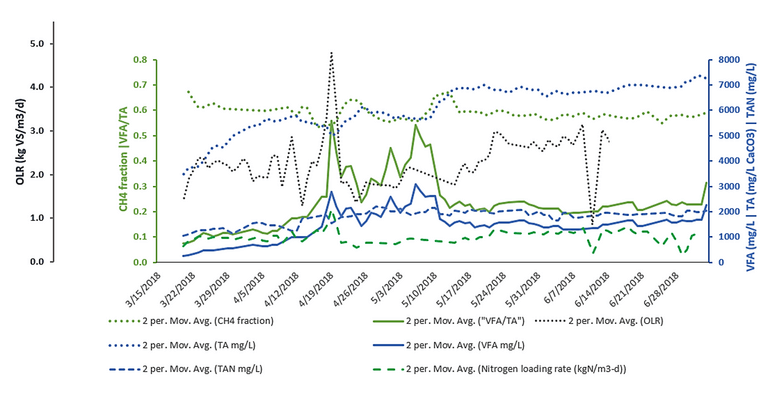
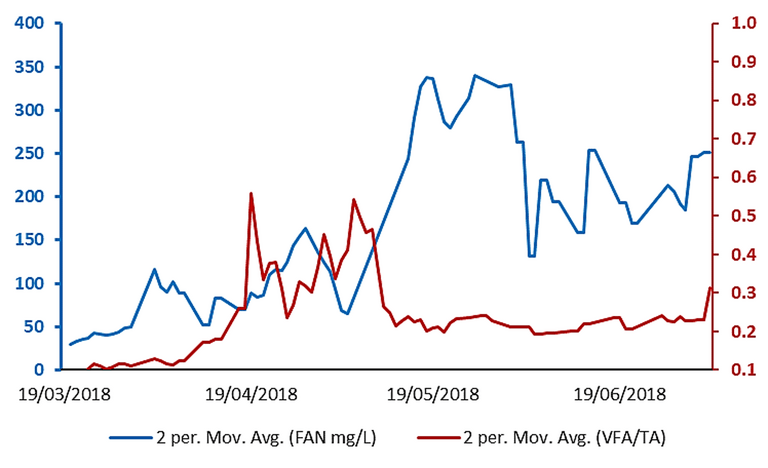
Transitioning from MAD to TH-AD demanded a gradual increase ('ramp-up') in temperature and pH, ultimately resulting in an increase in FAN. The first attempted ramp-up in mid-April caused a corresponding spike in VFA, which lowered the pH and thus the FAN (Fig. 2). While the OLR was rapidly reduced from 5.3 to 2 kgVS/m3/d, pH and T continued to increase and resulted in FAN levels elevated to above the threshold of 100 mg/L where acetoclastic methanogen inhibition would be expected.
Despite the steep increase in FAN concentrations from day 41 (mid-May) onwards, briefly exceeding 300 mg/L, the process operated at VFA/TA ratios below 0.3 and was therefore stable. It can therefore be concluded that increased ammonia levels to values frequently reported as inhibitory for acetoclastic methanogenic communities does not necessarily result in process inhibition or failure if conditions like the rate of change favour the development of ammonia-tolerant methanogens (such as Methanosarcina sp.).
3.2.2 Volatile fatty acid impact
The other possible trigger for digester failure could have been a high VFA loading rate, leading to the decoupling of methanogenesis from acidogenesis and acetogenesis. This can be assessed through the SELR trend (Fig. 3). According to this trend, it is clear that the SELR remained below the critical limit of 0.3 [1] despite the peak in VFA/TA recording in day 31. The periods of instability indicated by the high VFA/TA values related to a transition phase associated with adaptation to the high ammonia environment, rather than to digester failure.
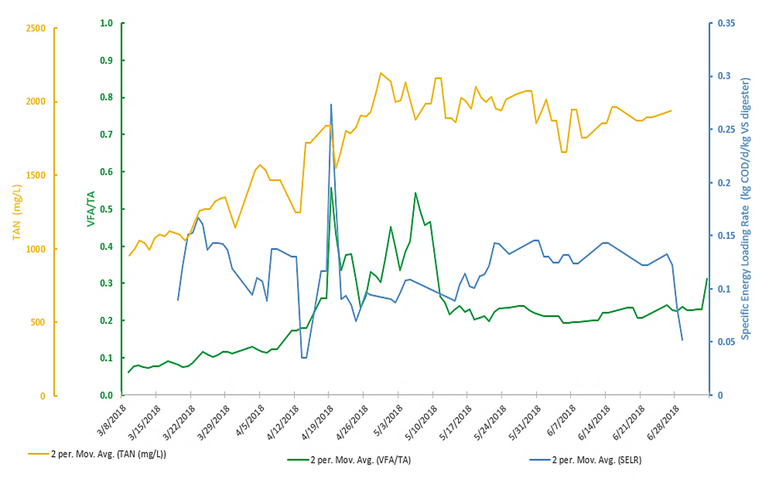
3.2.3 Volatile solids reduction and ammonia release
TH pre-treatment increased the VSR of the mixed sludge (70% PS: 30% WAS) from 50−56% to 57−64%, albeit with significant data scatter. This is within the 55−65% associated with normal operating TH-AD. A moderate but not significant VSR increase was observed on transitioning from MAD to TH-AD: TH has minimal impact on primary sludge biodegradability. VSR impacts are more significant for increased WAS fractions. Moreover, literature shows that VSR for thermal hydrolysis remains consistent with very little change at an SRT range of 10−18 days.
Hence, lower SRTs (i.e. higher throughputs) can be achieved once the microbial community has acclimatised to the high ammonia concentration. The extent to which the HRT can be lowered nonetheless depends on the limiting COD loading rate.
TH enhances ammonia release from organic bound nitrogen by 13%, and the percentage conversion of TAN released as FAN in the digester from 1.6% to 7.4% due to the increased digester temperature and slight increase in pH (Fig. 4). Overall, as a combined result of increased VSR and enhanced ammonia release from organic nitrogen compounds, TH increases ammonia release from VS by 38%. However, the high DS content of the TH-AD feed more than doubled the average TAN release − from 0.6 mg NH4 to 1.4 mg NH4 with reference to the feed sludge volume. Hence for TH-AD, both NLR and OLR are critical in maintaining digester stability compared to MAD where VFA/TA, in turn determined by OLR, is considered a priority.
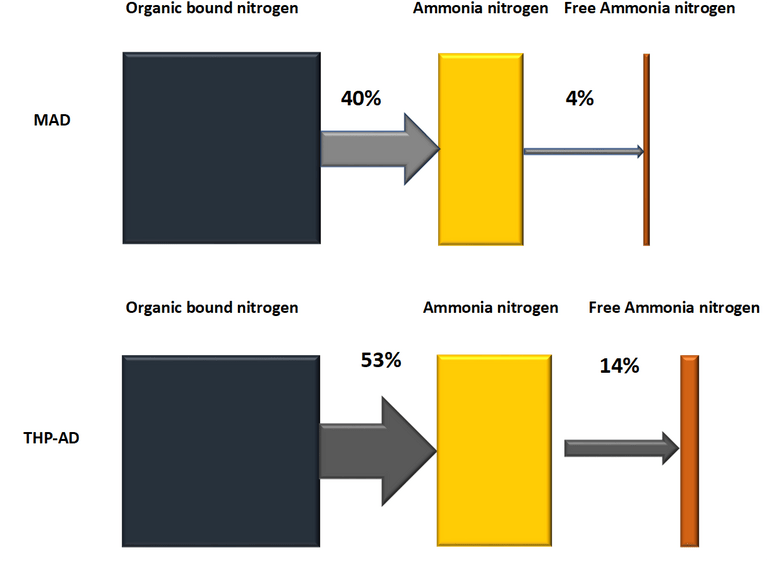
4. Key outcomes
4.1 Impact on feed sludge and digestate
Overall TH-AD enhances the solubilization of sludge particulate matter and thereby improves the overall kinetics of AD, albeit with the accompanying release of recalcitrant compounds from WAS in particular.
TH also significantly alters the sludge physical properties, with most of the changes arising within the first 30 minutes of reaction time, resulting in enhanced dewaterability (from 20 to 30% DS for the dewatered cake) as well as a reduced pumping and mixing energy demand.
4.2 Impact on digester performance
For MAD, an increased VFA/TA ratio is usually related to inhibited methanogenic activity caused by drop in pH through VFA accumulation, as determined primarily by the OLR. In this case, the VFA level can provide an early warning of digester failure.
The TH-AD process increases the digester ammonia levels by enhancing ammonia released per VS destroyed − by 38% for the current study. However, the major impact on digester ammonia increase in the current study was through the secondary effect of doubling the feed %DS, and so the digester ammonia levels.
It appears from this study that the commissioning of TH-AD induced a shift in microbial community (from dominant Methanosaeta sp. to dominant Methanosarcina sp.) in adapting to the increased ammonia levels. This shift is accompanied by increased residual acetate concentrations and/or a pH shift. Elevated VFA concentrations are generally considered to be an early indicator of digester failure for a conventional MAD by plant operators, effectively restricting the throughput to well below optimal levels at the site.
A consideration of VFA/TA alongside NLR and SELR at this site revealed the VFA/TA peaks to correspond to digester adaptation rather than an impending digester failure, since NLR and SELR were within the generally-recognised limits for stable operation. A multi-faceted approach can thus be taken to commissioning which may then achieve a higher target throughput than is normally considered optimal (Fig. 5).
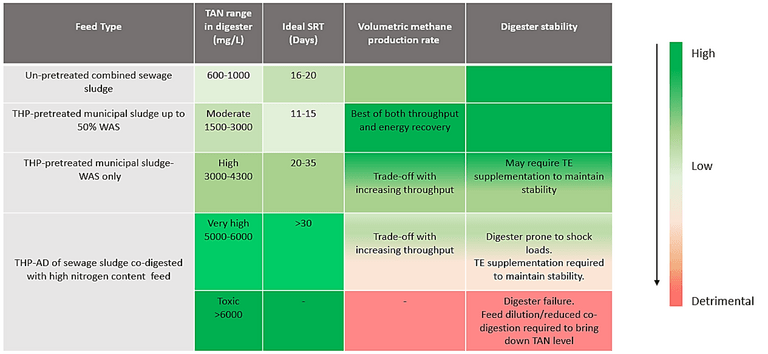
To achieve this operational state, feed dilution followed by a slow incremental increase in solids concentration can be effective in controlling the rate of ammonia accumulation to allow the digester microbial community to adapt to the increasing ammonia levels during commissioning. Any spike in VFA/TA ratio may then be considered ephemeral and an indication of microbial community adaptation, rather than process failure. Once this is realized, the TH-AD can run to its optimum capacity without risk of digester failure expected from running a conventional MAD. In the case of our study, this translates to more than doubling the OLR from its current state to reach optimal TH-AD operating capacity without any trade-off with optimal energy recovery. Accordingly, the stability indicators will increase, but will remain within the stability threshold limits of a successfully adapted digester (Table 3).
| Parameter | MAD | TH-ADsub-optimal,current | TH-ADoptimal |
|---|---|---|---|
| OLR (kg VS/m3/d) | 2−3 | 2−3 | 5−6 |
| VSR (%) | 50−56% | 57−64% | 57−64% |
| Biogas yield impact | - | - | 15-25% expected increase cf. MAD3 |
| Recorded/predicted FAN, threshold FAN (mgN/L) | <50, 100−150 | 200−300, ~550 [3] | 200−350, ~550 [3] |
| Recorded/predicted TAN, threshold TAN (mgN/L) | <1000, ~2000 | 1600−2000, ~4000[4] | 1700−2200, ~4000 [4] |
| SRT (days) | 16−20 | 28−30 | 11−14 |
| Residual VFA (mg/L) | <500 | 1300−2000 | 3000−6000 [5] |
| Temperature (°C) | ~37 | ~41 | ~40−42 |
| Total Alkalinity (mg/L as CaCO3) | ~3,500 | ~7,000 | 10,000−15,000 [5] |
| VFA/TA | <0.1 | 0.1−0.22 | 0.2−0.4 [5] |
5. Summary
The study outputs would appear to have significant implications regarding TH-AD optimisation. The study indicates that the stability of TH-AD can be sustained at higher throughput despite higher ammonia concentrations and, depending on the ammonia level, the operation of the digester may differ based on whether throughput is prioritised over energy recovery or vice-versa. Our analysis of the plant under study showed that a doubling of throughput is possible without compromising biogas yield despite an increase in the ammonia level. This is because the plant processes both primary sludge and WAS − with WAS fraction making up <50%, and hence, the ammonia levels remain in the moderate band. For TH-AD plants processing WAS-only sludge, throughput can only be increased at the expense of biogas yield. A strategic decision should therefore be taken as to the basis for TH-AD optimisation.


